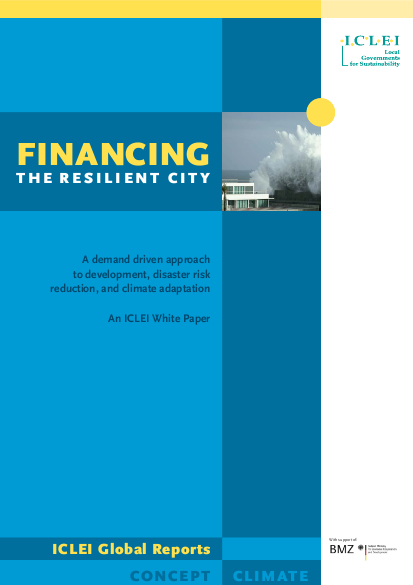A demand driven approach to development, disaster risk reduction, and climate adaptation

The report in brief
• The level of resilience of our cities and towns is dependent on the quality and performance of the overall urban system, not solely on the climate change adaptation of single infrastructure elements. • Adaptation to climate change is becoming increasingly relevant as the negative impacts of climate change increase. At the same time, awareness about disaster risk reduction is also a growing concern. • There needs to be a shift, in both adaptation to climate change and disaster risk reduction, from a singular and specifi c focus on aff ected infrastructures and locations towards a more integrated focus on overall risks, development conditions, and local area performance.
• The report calls for: • Mainstreaming climate and disaster risk reduction to become factors in conventional planning processes, project design and development decision making. • Developing specialized fi nancial instruments for the risk-oriented components of these projects that cannot be addressed via mainstreaming measures. • Building local institutional capacity to prepare, structure and manage large scale redevelopment • The right capacity must be available at the local level to leverage the right finance. Capacity is needed at the local level to organize eff ective demand for resilience as one of the key conditions for comprehensive resilience upgrading of vulnerable urban areas. This would allow locally driven, large and complex projects to advance as quickly as conventional top-down projects. • The challenge is to match local demand for resilience with the supply of fi nance. • Conditions at the local level for leveraging fi nance include: • Building capacity of bottom-up planning processes for identifying vulnerabilities and risks, and linking the related risk mitigation solutions with priority performance enhancements in relevant areas or systems. • Ensuring bottom-up technical and institutional capacity for designing comprehensive resilience upgrading projects; for managing and staging complex project execution; and for preparing the diff erent investment propositions related to diff erent components of these projects. • Suporting the bottom-up procurement of investment through managed, competitive sourcing mechanisms and processes.
• In addition, there are challenges to the supply of finance: • The market for resilience fi nance requires a high degree of responsiveness to differentiated demand, so that the projects themselves can be locally responsive. • Markets require a considerable degree of standardization of the investment propositions and predictability about the pipeline and subsequent performance of the propositions. • Industry needs to learn how to integrate resilience as a new design and project performance element into the front-end of project planning and product design. Until then there could be a need for new, non-conventional fi nancing instruments to support initial resilience upgrading.
Resource collections
- Prioritisation
- UN Habitat - Urban Response Collection
- Urban Response - Urban Crisis Preparedness and Risk Reduction
- Urban Response Collection - Community Engagement and Social Cohesion
- Urban Response Collection - Economic Recovery
- Urban Response Collection - Environment and Climate Change
- Urban Response Collection - Housing, Land and Property
- Urban Response Collection - Urban Crisis Response, Recovery and Reconstruction
- Urban Response Collection - Urban Resilience